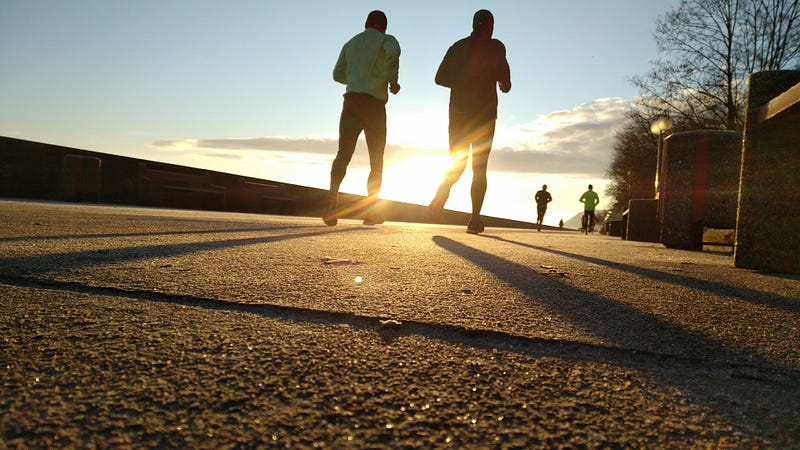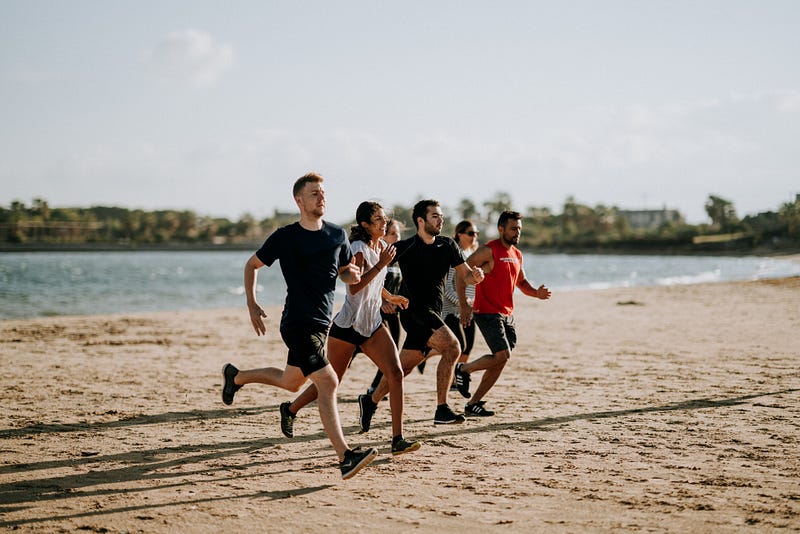A look around the locker room of my cross country team usually yielded a stark result, once you started to pay attention to it: everyone in the locker room would be almost completely white, with the exception of one or two teammates.
That reality, as well as my just looking at the usual field of marathon runners in all three marathons, shows a message that everyone knows, but might not want to think about:
The world of running is very, very white.
Let me give some disclaimers. Of course, some of the most successful runners in the world are not white, as athletes in Ethiopia and Kenya reign supreme at events above 400 meters on the track, and tend to dominate the world of long-distance running. The world of running being "too white" particularly pertains to the west, to the world I see and grew up in. In addition, in track and field, any events 800 meters and below are not as white, and more accessible and representative of America's racial demographics.
If I were to be precise, the world of American distance running is very white. A quick look through LetsRun forums confronting the whiteness of running breeds a lot of hostility. Questions like the following are asked: why is something being white a bad thing? Why are people bringing up the "whiteness" of running "leftist trolls"? The comments quickly bring up racist tropes of crime, welfare, laziness, unemployment, and a lot worse that I won't even mention. Sure, the anonymity of LetsRun and the general Internet give a lot of these people license to make more bigoted comments, but reading through it only reinforces the notion that distance running is a very white sport, and something needs to change.
Running being predominantly white is a bad thing. It means it isn't accessible, or isn't perceived as accessible to large portions of our population.
Running has done a lot for me. Most of my friends, to this day, are runners. I know runners to be the toughest, most welcoming, most loyal, and kindest people I've ever met, not only in racing and performance but in their devotion to teammates. I would not be the person I am without running and the community it provides. Perhaps that makes me biased when writing about the whiteness of the running world, given that all but a couple of my running friends are white.
But someone said these words a long time ago that stuck with me: the problem with white privilege isn't that white people tend to be more privileged than minorities. The problem is that the privilege isn't extended to all. And so the solution shouldn't be just to have less white people run, but find a way to make the world of distance running more accessible to everyone.
 Photo by Tomasz Woźniak on Unsplash
Photo by Tomasz Woźniak on UnsplashIdeally, running should be some sort of equalizer. It's not a very financially restrictive sport to get into, as all the equipment you need is a pair of trainers, according to Duncan Craig of Runner's World. But it's not that simple. To be a runner, you need a safe place to run, the free time required to run, adequate food in the fridge.
I am only going to speak from personal observations, but the places that people run tend to be concentrated in the suburbs or gentrified areas of cities. A lot of people don't run in high-crime, low-poverty areas for fear of safety, and yet high-crime, low-poverty areas are disproportionately segregated. I don't just read about residential segregation in academia: I live and see it every day, teaching in an inner-city school with only a single white kid of about 350. I can't quite put my finger on what's so wrong with the fact that segregation happens in a much more covert, de facto, manner, but what I can say is that it's not good for running's perceived accessibility to non-white Americans.
The whiteness of running in America is then a class issue as well as a race issue. Why does distance running disproportionately target middle to upper-class Americans? For me, commercially there's not much in running. Very, very few people in America are going to become distance running stars who make money off of their running. America simply doesn't have a market for running the same way it does for basketball or football, and it's a simple fact that there's much more money to be made as a distance runner.
The book "Stuff White People Like," a satirical book that takes aim at hipster, liberal, white self-proclaimed allies of minorities, describes marathon running as number 27 on its list. In a 2011 study of nearly 12,000 respondents from Running USA's National Runner Survey, runners who entered running events and trained year-round were 90 percent white, 5.1 percent Hispanic, 3.9 percent Asian/Pacific Islander, and 1.6 percent African-American, a study consistent with Runner's World surveys, according to writer Jay Jennings.
When I brought it up with my running friends, from trusted mentors to friends to old teammates, my friends often brought up the point that while running is a white sport, its inaccessibility isn't as egregious as many other sports that require expensive equipment, like golf, tennis, cycling, lacrosse, and skiing. But just because running isn't as bad as golf, tennis, cycling or lacrosse, doesn't mean that the running community can't do better to extend the privilege we receive of good physical health, an incredibly supportive community, and better mental health.
I believe that the sport has so much good to offer that it should transcend racial and socioeconomic barriers. Why doesn't it?
Jay Jennings reported on the ingrained stereotypes, institutional complacency, cultural resistance behind why running remains so white. Jennings interviewed Tes Sobomehin, who said a major reason for her not taking up running before was a lack of role models and representation. Kevin Lyons, a black journalist in Austin, Texas, and an avid runner, similarly expresses the lack of African-American runners. He admits that he didn't start watching golf until Tiger Woods came along.
A group called Black Girls RUN! (BGR!), a national organization of black girl women runners, has two founders: Ashley Hicks and Toni Carey. Carey shares a personal anecdote about when she decided to start running and her mother told her: "Well, black people don't run." The comment inspired Carey and Hicks to start BGR!, which now has chapters in more than 40 cities. In the Jounral of Health Psychology, a 2000 study shows that the top barrier to physical activity for African-American women aged 40 and older was "lacking a safe place to exercise."
Until I went to live in Japan for 10 weeks, I didn't see many Asian representations of runners either. In my own experience, I only started running as an accident. I missed the bus one day in 7th grade and then the next bus wouldn't come until an hour and a half later. My friend asked me to join the cross country team. I said no, and then he uttered some obscenities to imply that I would be less of a man if I didn't join the team, and then I joined the cross country team. I felt like I was going to die on the very first run, and I hated myself so much that I went back every day.
 Photo by Unsplash on Unsplash
Photo by Unsplash on UnsplashOf course, I know now that giving into the peer pressure to run was the best decision I made in middle school. But the racial diversity of distance running is a very complicated and delicate issue. African runners in the United States still dominate the sport, but American-born minority distance runners feel discouraged from making an impact. The sport simply hasn't had many American-born minority distance runners to look up to. It can seem like a nitpicky distinction, but it's there, regardless, which does not mean that naturalized distance runners are any less American, but does mean that running can seem less accessible for American-born minorities.
Representation matters. But it's not everything. I am never going to be an Olympic-level athlete and inspire a whole generation of Asian-Americans to be runners. The onus does not just fall on runners, but on institutions that have power and clout in the running world — the running media, shoe companies, advertisements and race organizers.
"For the most part, you see white guys and gals," says Jean Knaack, the executive director of the RRCA (Road Runners Club of America). Running industry businesses and shoe companies can do a much better job representing minorities, and high school track coach, Charlotte Lettis Richardson makes the key note that women once struggled to gain acceptance in distance running, and that the running industry ignores women the same way it does minorities now. While Nike supported Richardson and other women, that outreach has not been extended to minorities.
The path forward
Of course, the problem of distance running being too white is not going to change overnight. But there's a lot of things the running industry and runners ourselves can do better to increase minority participation in running. After all, running has a lot of physical and mental health benefits and a wellspring of welcoming and kind people. To do better, media and running industries need to increase minority representation, but again, that 's not everything.
If you're anything like me, you're just someone who likes to run. The running world being too white isn't something I think about all the time, but it is something that bothers me when I do think about it. I don't want to seem ungrateful to the running world and my closest friends, teammates, and coaches who are white runners, because they played significant roles in shaping who I was.
However, a little effort from all of us goes a long way. Try not to be the person that says "I'm colorblind. I'm not racist, and it's not my problem." After all, no one can really be blind to color and no one can truly say they don't have any racial prejudices. The most important thing we can be when we're thinking about race is self-aware, and in my self-awareness, I know that I'm just as racist as the next person when I walk through a high-crime area, carry less cash, and lock my car a few times more than I normally would.
Real success comes in a grassroots way. Race directors can promote events that support causes in minority neighborhoods like diabetes prevention. Coaches across the country can encourage more students of color to try distance events, not just middle or short distance events.
As individual runners, we can do more outreach ourselves. Invite our friends and co-workers of color to start running with us. Very few people don't want to be in good shape, so the responses may surprise you. If you have access to a car, give your friends a ride to go running with you. And if the fact that your entire locker room is white or most of your running friends are white unsettles you, don't just sit on that feeling. Think, too, about why running is so white, and what we can do about it.
None of these actions are going to cure the diversity problem of running. The world, however, is changing very, very fast, and I hope it changes soon to make running less of a white person thing. Running is very quickly gaining popularity, and soon cable sports channels are going to be showing more meets or even more distance races. There will be more money in running. I have often heard, from my non-running friends, that the reason they don't run longer distances is because watching someone run a mile, 2-mile, or 5k is very boring. Well, my response is that it's boring because you're not doing it, and the market for running on social media has accelerated recently, especially on YouTube with significantly more people viewing long-distance races and training videos.
However, let us not be stirred into a sense of complacency. Yes, running might just have a slower path to becoming less white than basketball or football, but running's diversification cannot come if gentrification keeps happening in America's major cities as well.
There are no easy answers.
No solution is going to fix running being too white just like there has been no easy solution for poverty, residential segregation and white flight. Running is often exclusive to trails, suburbs, and gentrified areas of cities. I have never seen that many people running through the hood at all.
But if the effort to diversify running is anything like running a marathon itself, then the effort is not going to be easy. It will be messy, painful, and require a lot of grit and determination from a lot of people. Like the marathon, it will probably take a very long time. To make running less white, all the pieces are going to matter.



















